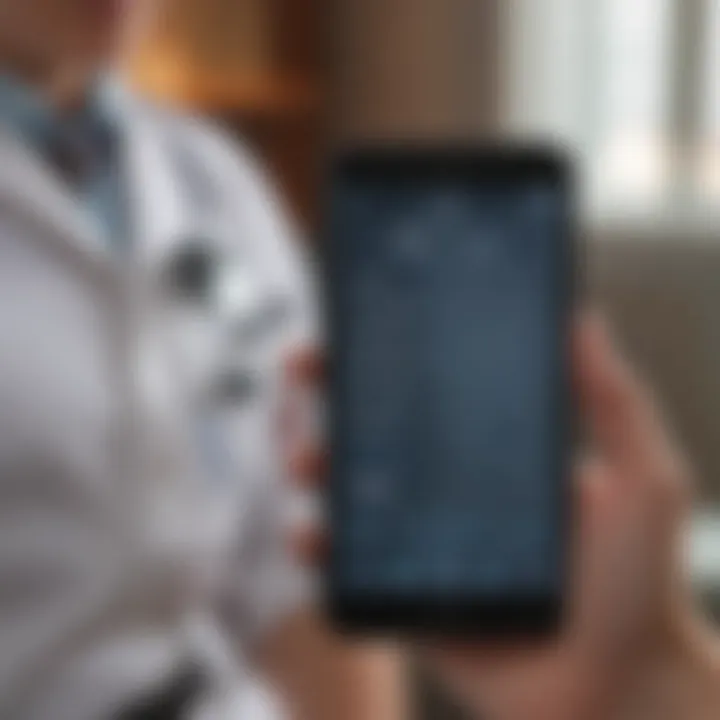The Evolution and Impact of Healthcare Apps


Intro
The landscape of healthcare has undergone significant changes in recent years, primarily driven by the emergence of healthcare applications. These applications have transformed how patients engage with their health, enabling more informed and timely decisions. As mobile technology advances, the integration of these applications into everyday healthcare practices has become increasingly vital.
Healthcare apps are tools designed to support health management by offering various functions, including tracking medical conditions, scheduling appointments, and facilitating direct communication between patients and medical professionals. Their development reflects not just technology's evolution but also a shift toward patient-centered care, where individuals are actively participating in their health management. Understanding these technologies' evolution and impact is crucial for future advancements in the medical field.
In this article, we will explore the critical aspects of healthcare apps, detailing their transformative role, the benefits they offer, and the challenges they face moving forward. Through this exploration, a comprehensive understanding of healthcare apps will be established, providing insight into how they can better serve patients and practitioners alike.
Intro to Healthcare Applications
Healthcare applications are pivotal in the current landscape of digital health. They bridge the gap between complex medical processes and practical solutions for patients and healthcare providers. Understanding healthcare applications is essential, as they shape how people manage their health, interact with medical professionals, and access information.
Definition and Classification
Healthcare applications can be defined as software designed specifically to aid individuals in managing their health needs. These apps serve various functions, ranging from basic information dissemination to more complex tasks like monitoring vital signs or facilitating telemedicine consultations. They can be broadly classified into several categories:
- Telemedicine applications: Enable remote consultations and follow-ups, allowing patients to connect with healthcare providers without being physically present.
- Fitness and wellness trackers: Monitor daily activities such as steps taken, calories burned, and sleep patterns, promoting a healthier lifestyle.
- Medication management software: Help users keep track of medications, dosages, and schedules.
- Chronic disease management tools: Target specific health conditions, offering tailored insights and monitoring to support patient care.
These classifications highlight the multifaceted nature of healthcare applications, each serving unique functions while collectively enhancing health management.
Historical Context
The history of healthcare applications is intimately tied to advancements in technology. In the early days, health management was limited to paper records and face-to-face consultations. However, with the rise of personal computing and smartphones, a shift began.
In the late 1990s and early 2000s, rudimentary health management software emerged, primarily for healthcare professionals. These tools provided basic functionalities like patient data entry and appointment scheduling. As the smartphone revolution took off in the late 2000s, healthcare apps proliferated, made accessible to consumers at large.
From then, applications began incorporating advanced features such as real-time data tracking, integration with electronic health records, and personalized health insights. This evolution mirrors a growing public desire for autonomy over personal health choices, fostering increased engagement in health management. Over the years, innovations in connectivity, data analytics, and machine learning have only accelerated the development and sophistication of healthcare applications. This dynamic interplay of technology and consumer demand has laid the groundwork for the robust ecosystem of healthcare applications we see today.
The Technical Framework
The technical framework serves as the backbone of healthcare applications, enabling their functionality and efficiency. This framework encompasses various components, including development platforms, tools, and methods that facilitate the design and implementation of these apps. Understanding the technical aspects is crucial in appreciating how these applications operate, their integration with existing healthcare systems, and their potential benefits and threats to data security and user privacy.
Development Platforms and Tools
In creating healthcare applications, developers rely on various platforms and tools that assist in the design, coding, and testing processes. Commonly used development platforms include Android Studio for Android development, Xcode for iOS applications, and React Native, which allows for cross-platform development. Each platform offers distinct advantages:
- Android Studio: It enables extensive customization and integration with Google services, making it ideal for Android-focused applications.
- Xcode: Exclusively for iOS, this platform provides a rich development environment, ensuring that apps are optimized for Apple devices.
- React Native: This allows developers to use a single codebase for multiple platforms, reducing time and cost while maintaining performance.
Whether a developer opts for native or cross-platform tools affects not only the application's performance but also user experience. Selecting the right platform lays the foundation for a successful app.
Data Security and Privacy Considerations
Data security and privacy are paramount when it comes to healthcare applications. Protecting sensitive patient data is not just a legal obligation but also crucial for maintaining user trust. Several factors should be considered when developing secure healthcare applications:
- HIPAA Compliance: Applications must comply with the Health Insurance Portability and Accountability Act (HIPAA), which sets the standard for protecting sensitive patient information in the United States.
- Encryption: All sensitive data, both in transit and at rest, needs to be encrypted. This ensures that data breaches cannot easily expose patient information.
- User Authentication: Implementing robust authentication processes, like multi-factor authentication, can effectively increase security by adding an extra layer of protection.
- Regular Updates: Conducting regular updates and security patches is essential to protect against emerging security threats and vulnerabilities.
"Security is not a product, but a process." This highlights that safeguarding patient data is an ongoing effort that requires vigilance and adaptation as technologies evolve.
Types of Healthcare Apps
The diversity of healthcare applications plays a pivotal role in modern health management. Understanding the different categories of these apps illustrates their varied functions and advantages. Such insights are critical for stakeholders aiming to improve patient care, increase efficiency, and harness technology for better health outcomes. Moreover, recognizing the specific elements and benefits of each app type helps users make informed choices about their health management tools.


Telemedicine Applications
Telemedicine applications allow patients to consult with healthcare professionals remotely. These platforms, such as Teladoc and Amwell, provide convenient access to medical advice and services without the need for in-person visits. This type of application has several important benefits:
- Accessibility: Patients in rural or underserved areas can connect with specialists they might otherwise never reach.
- Time-saving: Both patients and providers save time with reduced travel and waiting periods.
- Cost-effectiveness: Telemedicine can lower healthcare costs by minimizing unnecessary emergency room visits.
These applications have transformed healthcare delivery, especially during the COVID-19 pandemic when physical distancing became essential. However, they also face challenges like regulatory barriers and a need for strong data security.
Fitness and Wellness Trackers
Fitness and wellness trackers empower users to monitor their physical activities, sleep patterns, and nutritional intake. Popular apps like MyFitnessPal and Fitbit encourage healthier lifestyles by providing data that helps users identify patterns. The benefits include:
- Personalization: Users can tailor fitness goals based on their unique data.
- Motivation: Many apps offer rewards or community challenges to keep users engaged in their health journeys.
- Health Insights: Users can gain valuable insights into their habits, aiding in long-term health management.
However, reliance on these apps raises concerns around data privacy and accuracy. Users must navigate terms of service carefully to understand how their personal information is used.
Medication Management Software
Medication management software, such as Medisafe and Pill Reminder, addresses the challenges of medication adherence. These applications provide reminders, track prescriptions, and monitor refills. Their advantages include:
- Improved Adherence: Users are less likely to miss doses with timely notifications.
- Interaction Checks: Many apps assess potential interactions between concurrent medications.
- Information Storage: Users can store important information about their medications, which is useful for doctor appointments.
Overall, these apps significantly enhance medication safety and effectiveness, particularly for individuals managing multiple prescriptions.
Chronic Disease Management Tools
Chronic disease management tools, like Glucose Buddy and MyTherapy, cater to those with long-term health conditions. These applications allow users to record symptoms, track medications, and share data with healthcare providers. They offer:
- Real-time Monitoring: Patients can monitor their condition actively, promoting proactive health management.
- Data Sharing: Simplified reporting to healthcare providers improves communication about the patient's status.
- Tailored Support: Users can receive customized advice based on their input data.
These tools play a crucial role in empowering individuals, leading to better management of chronic diseases and improved quality of life. They also support healthcare professionals in making informed treatment decisions.
"The evolution of healthcare applications is not just a trend; it is an essential shift towards a more effective and efficient healthcare system."
In summary, the classification and functionality of healthcare apps vary significantly. Each type addresses unique needs within the healthcare environment, contributing to enhanced patient outcomes, improved healthcare delivery, and increasingly efficient health management.
User Engagement and Adoption
User engagement and adoption are critical factors in the overall success of healthcare applications. The effectiveness of these apps hinges not only on their functionality but also on how well they resonate with their intended users. Higher engagement levels often lead to improved health outcomes as users become more proactive in managing their health. When users find an application engaging and intuitive, they are more likely to utilize its features consistently.
User Experience Design in Healthcare Apps
User experience design (UXD) plays a fundamental role in how patients and healthcare providers interact with healthcare apps. A well-designed interface ensures that users can navigate seamlessly through the app features, accessing the information they need without difficulty. The design should be visually appealing, yet functional. Important design considerations include:
- Simplicity: Complicated interfaces can overwhelm users. Keeping functionality straightforward encourages repeated use.
- Accessibility: Apps must be usable for diverse populations, including those with disabilities. Adhering to accessibility standards can enhance overall user engagement.
- Feedback Mechanisms: Providing real-time feedback helps users understand their actions within the app. For example, notifications or confirmations can guide users effectively.
- Customization Options: Allowing users to personalize their experience can make them feel more invested in using the app. Options might include adjustable font sizes, themes, or content preferences.
Incorporating these elements can create a more satisfying user experience, ultimately fostering a loyal user base.
Barriers to Adoption
Despite the clear benefits of healthcare apps, several barriers hinder user adoption. Identifying these challenges is essential for developers and stakeholders. Common barriers include:


- Lack of Awareness: Many potential users may not realize the existence or utility of certain healthcare apps. Education and outreach can bridge this gap.
- Technical Barriers: Users may struggle with technology itself. Older populations or individuals unfamiliar with digital tools might find it difficult to navigate new apps.
- Data Privacy Concerns: Security issues are paramount in healthcare. If users perceive that their data may be at risk, trust will diminish, impacting the adoption rate.
- Integration with Existing Systems: Healthcare providers are often hesitant to adopt new technologies that do not integrate smoothly with their established workflows. This reluctance can stymie the uptake of healthcare apps.
"Understanding the barriers to adoption is crucial for creating solutions that resonate with users and healthcare providers alike."
Addressing these barriers is vital for the successful implementation and sustained usage of healthcare apps, leading to improved patient engagement and better health management outcomes.
Impact on Healthcare Delivery
The integration of healthcare applications into the medical landscape signifies a pivotal evolution in healthcare delivery. These applications do not merely serve as tools; they redefine the relationship between patients and providers. The shift from traditional practices to digitally-driven solutions reflects a growing awareness of the need for efficiency, accessibility, and personalized care within the healthcare system. Understanding these aspects is vital, as they highlight the significant transformations that are shaping modern healthcare.
Improving Patient Outcomes
Healthcare applications enhance patient outcomes substantially. They empower users by providing accurate information, timely reminders for medication adherence, and easy access to medical advice. For example, applications like MyChart and Medisafe allow patients to manage their prescriptions and appointments effortlessly. Research shows that when patients engage actively in their health management, they tend to experience better outcomes. This leads to reduced hospital readmission rates and improved disease control.
Moreover, these applications foster proactive health monitoring. Patients with chronic conditions, such as diabetes or heart disease, can track their vital signs and symptoms through specific apps. This data can be shared with healthcare providers, enabling early intervention when necessary, which is crucial in preventing severe complications.
"Digital health applications can lead to significant improvements in disease management and patient insights, ultimately enhancing the quality of care provided."
By collecting data through wearables and apps that monitor daily activity and health parameters, patients become more informed about their health status. Therefore, patients not only receive treatment but also develop a deeper understanding of their health journey.
Shifting the Role of Healthcare Providers
The role of healthcare providers is also undergoing transformation due to these applications. Traditionally, providers operated in a more reactive mode, responding to patient issues as they arose. Now, they are transitioning towards a more proactive and participatory approach.
Healthcare apps facilitate communication between patients and providers. Tools such as telemedicine platforms expand access to care. Providers can now consult with patients remotely, reducing barriers of geography and travel time. This shift is particularly crucial for individuals in rural areas, where access to healthcare services may be limited.
Furthermore, healthcare apps offer providers valuable insights into patient behavior and health trends. By leveraging data collected through these platforms, providers can tailor interventions to meet specific patient needs. This personalized approach enables more targeted treatments and, ultimately, leads to better patient satisfaction.
As apps grow in popularity, healthcare professionals must adapt their practices to better utilize these tools. Continuous education and training in digital health technologies become essential for maintaining effective patient-provider relationships in this evolving landscape.
Challenges and Limitations
The landscape of healthcare applications is not without its challenges and limitations. While these apps offer significant potential to enhance health management, there are inherent issues that can hinder their effectiveness and acceptance. This section discusses two critical aspects of the barriers facing healthcare applications: regulatory and compliance issues, along with the essential nature of maintaining user trust.
Regulatory and Compliance Issues
Healthcare applications operate within a highly regulated environment. Ensuring compliance with governing laws and regulations is crucial for their development and deployment. These regulations vary by country and can include laws regarding data protection, such as the Health Insurance Portability and Accountability Act (HIPAA) in the United States or the General Data Protection Regulation (GDPR) in Europe.
A primary challenge involves balancing innovation with compliance. Developers must stay updated with evolving regulations, which can shift rapidly. Failure to comply can result in severe penalties, including fines and restrictions on app usage. This creates a cautionary landscape for developers, often leading to cautious, slower development cycles.
Moreover, the integration of new technologies like artificial intelligence raises further regulatory concerns. These advancements can blur the lines of existing regulations, necessitating fresh guidelines. Engaging with regulatory bodies early in the development process can help identify potential pitfalls. Incorporating legal experts during app design is invaluable, as they can offer guidance on compliance while maintaining product innovation.
"Neglecting compliance in the healthcare app sector can jeopardize not only user safety but also the viability of the applications themselves."
Maintaining User Trust
Trust is a cornerstone of healthcare, and applications must cultivate this quality to be accepted by users. Users are more likely to engage with apps that prioritize their privacy and security. Given the sensitive nature of health data, any data breach or misuse can lead to significant consequences.
Healthcare apps must communicate transparently about how data is collected, stored, and utilized. Users should have clear access to privacy policies that outline their rights and the app's obligations. A failure to establish trust can result in low adoption rates, despite the app’s potential benefits.
Additionally, maintaining user trust requires continual updates and improvements. Engaging with users through feedback mechanisms can identify areas of concern and demonstrate responsiveness. Regular updates not only fix issues but also reassure users that their security is taken seriously.


Trust-building also involves third-party partnerships. If a healthcare app integrates with other tools or services, users must perceive these partnerships as reputable and secure. Building strong relationships with recognized health organizations can enhance credibility and trustworthiness of the app.
Case Studies
Case studies serve a crucial role in understanding the evolution and impact of healthcare applications. They provide real-world examples of how these apps are integrated into healthcare systems, showcasing both successful implementations and critical lessons learned from failures. Evaluating case studies allows stakeholders to appreciate the practical aspects of app use, from usability to patient engagement, and helps them identify best practices.
Successful Healthcare App Implementations
Successful healthcare app implementations highlight the potential of technology to enhance health management. For instance, the app MyFitnessPal has transformed how people approach diet and exercise. It provides users with tools to track their food intake and physical activity, promoting healthier habits. This app has been effective due to several factors:
- User-Centric Design: Its intuitive interface attracts and retains users, making the experience seamless.
- Comprehensive Features: MyFitnessPal includes a vast food database which simplifies tracking.
- Community Interaction: The app encourages social sharing, which enhances motivation and support among users.
Analyzing similar case studies can yield insights into how apps can improve adherence to treatment protocols, enhance patient-provider communication, and provide personalized feedback. Another noteworthy example is Teladoc Health, which has expanded access to healthcare through virtual consultations. This service illustrates how effective implementation can bridge gaps in care, especially in underserved regions.
Lessons from Failed Applications
On the other hand, failures in healthcare applications offer valuable lessons. The outcome of the app HealthSpot is a prime example. It aimed to facilitate remote consultations but faced significant barriers:
- Technical Difficulties: Users experienced issues with connectivity and responsiveness during virtual visits, leading to frustration.
- Regulatory Hurdles: Compliance with healthcare regulations proved to be a significant challenge. This highlighted the need for thorough evaluation of legal and operational requirements.
- Lack of User Engagement: The app did not engage users effectively, leading to low adoption rates.
Understanding these lessons is vital for future endeavors. Analyzing what went wrong in failed applications can guide developers and stakeholders in creating more robust and user-friendly apps that meet the needs of the healthcare community. >"Failures serve as a learning opportunity. Without understanding missteps, progress is impeded."
Future Directions in Healthcare Apps
The future of healthcare applications is pivotal in shaping the overall landscape of medical care. As technology continues to evolve, healthcare apps play a significant role in enhancing patient engagement, improving accuracy in care delivery, and optimizing operational efficiencies across health systems. This section will explore specific elements that will define the trajectory of healthcare apps, the benefits they offer, and key considerations for stakeholders involved in their development and implementation.
Emerging Technologies and Innovations
The integration of emerging technologies into healthcare applications is crucial. Innovations like augmented reality (AR), virtual reality (VR), and blockchain technology are being harnessed to improve both patient education and data securety.
- Augmented Reality and Virtual Reality: These technologies offer unique ways for patients to immerse themselves in their health education. For instance, VR can simulate medical procedures, providing patients an understanding of what to expect.
- Blockchain: It enhances data privacy by providing a secure method of storing patient data. This is particularly important as concerns over data management grow.
- Wearable Health Tech: Devices like the Fitbit or Apple Watch can track health metrics that apps can utilize to provide tailored healthcare solutions.
Incorporating these technologies is not without challenges, though. Developers must ensure compliance with healthcare regulations while addressing user experience needs.
Predictive Analytics and Artificial Intelligence
Predictive analytics and artificial intelligence (AI) represent a transformative force in healthcare applications. By analyzing vast amounts of data, these technologies can identify patterns that human providers may overlook.
- Enhanced Decision-Making: AI can assist providers in diagnosing conditions more accurately. For example, algorithms can assess imaging data faster than traditional methods.
- Patient-Specific Insights: Predictive analytics can provide tailored recommendations based on a vast array of data points, improving personalized care.
- Operational Efficiencies: AI can streamline administrative tasks like scheduling and billing, thus allowing healthcare professionals to spend more time focusing on patient care.
As the reliance on data grows, it is vital to ensure the ethical use of AI in healthcare. Issues related to data bias and transparency must be addressed to maintain trust in these technologies.
Ending
In this exploration of healthcare applications, it is essential to consider how these tools have fundamentally reshaped modern health management. The integration of healthcare apps not only enhances patient engagement but also fosters an environment of proactive health monitoring. As healthcare becomes increasingly digital, these applications provide significant avenues for improving care delivery and patient empowerment.
Summary of Key Points
Healthcare apps have transitioned from simple tools to complex systems that integrate with various aspects of health management. Key points include:
- Definition and Classification: Understanding healthcare apps is crucial for identifying their roles in patient care and the medical field.
- User Engagement: User experience and barriers to adoption are vital for successful implementation.
- Impact on Delivery: The shift in roles for healthcare providers highlights the importance of technology in care coordination.
- Challenges: Regulatory and privacy concerns remain obstacles to be addressed.
- Future Innovations: Emerging technologies like predictive analytics can further transform healthcare applications.
Call to Action for Stakeholders
For stakeholders in the healthcare ecosystem, addressing the challenges and maximizing the benefits of healthcare apps demands strategic action. Recommendations include:
- Invest in User-Centric Designs: Enhancing the usability and accessibility of apps promotes greater user engagement.
- Emphasize Security: With rising data breaches, prioritizing privacy and security measures will build trust among users.
- Collaborate Across Sectors: Partnerships between tech innovators, healthcare providers, and policymakers can lead to effective solutions.
- Engage Patients: Actively involving patients in the design and delivery of apps ensures that their needs are met, fostering a culture of participatory healthcare.
The future of healthcare applications is bright, filled with potential that can redefine patient experiences and clinical outcomes.



